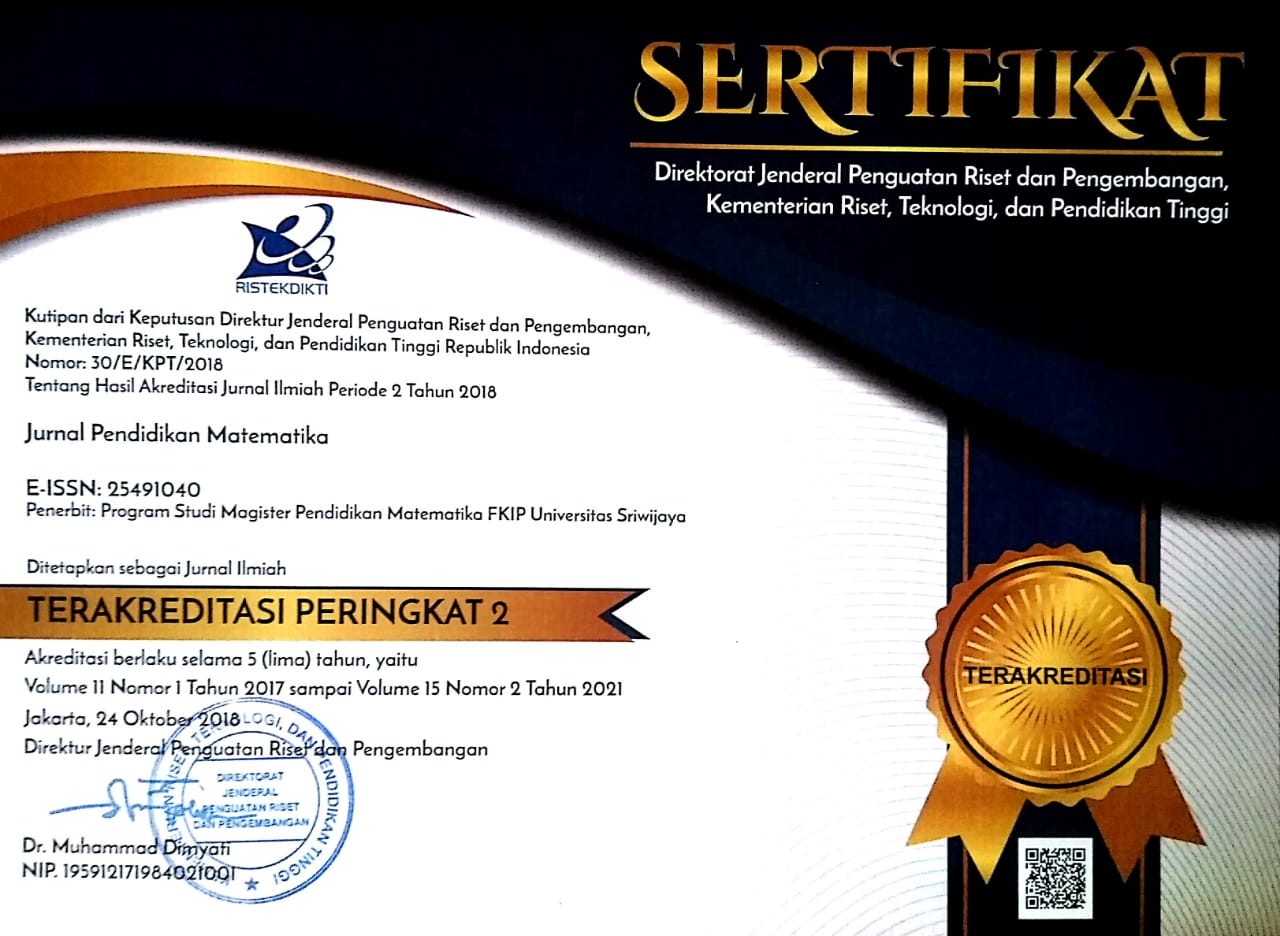PENINGKATAN KEMAMPUAN REPRESENTASI MATEMATIS MELALUI PEMBELAJARAN COLLABORATIVE PROBLEM SOLVING
Abstract
Tujuan dari penelitian ini adalah untuk menganalisis peningkatan kemampuan representasi matematis siswa melalui pembelajaran CPS. Metode penelitian yang digunakan adalah penelitian kuantitatif dengan kuasi eksperimen. Sampel penelitian ini sebanyak 63 siswa SMA Gumay Talang. Kelas eksperimen memperoleh pembelajaran CPS, kelas kontrol memperoleh pembelajaran konvensional. Pengumpulan data dilakukan melalui tes representasi matematis siswa. Data dianalisis menggunakan perbedaan rerata dengan uji Mann-Whitney. Dari analisis data diperoleh bahwa peningkatan kemampuan representasi matematis siswa yang memperoleh pembelajaran CPS lebih tinggi secara signifikan daripada siswa yang memperoleh pembelajaran konvensional.
Keywords
Full Text:
PDFReferences
Creswell, J. W. (2013). Research design: Pendekatan kualitatif, kuantitatif dan mixed. Yogyakarta: Pustaka Pelajar.
Dahlan, J. A. & Juandi, D. (2011). Analisis representasi matematik siswa sekolah dasar dalam penyelesaian masalah matematika kontekstual. Jurnal Pengajaran MIPA. 16 (1).
Danoebroto, S. W. (2015). Teori belajar konstruktivisme Piaget dan Vygotsky. Indonesia Digital Journal of Mathematics and Educationl. 2 (3).
Davidson, N. & Major, C. H. (2014). Boundary crossing cooperative learning, collaborative learning, problem based learning. Journal on Excellence in College Teaching. 25 (3), 7-55.
Depdiknas. (2006). Permendiknas Nomor 22 Tahun 2006 Tentang Standar Isi Sekolah Menengah Atas. Jakarta: Depdiknas.
Dillenbourg, P. (1999). What do you mean by collaborative learning? Collaborative-learning: Cognitive and Computational Approaches. Oxford: Elsevier.
Goldin, G. A. (2008). Perspective on representation in mathematical learning and problem solving. English, D. & Kirshner, D. (ed.) Handbook of International Research in Mathematics Education. 176-201.
Gokhale, A. A. (1995). Collaborative learning enhances critical learning. Journal of Technology Education, 7 (1).
Hwang, et al,. (2007). Multiple representation skills and creativity effects on mathematical problem solving using a multimedia whiteboard system. Educational Technology & Society, 10 (2), 191-212.
Hesse, F. et al,. (2015). A framework for teachable collaborative problem solving, Assesment and Teaching of 21st. New York: Springer.
Laguardo, J. M. (2015). Cooperative learning aproach in an outcomes based environment. International Journal of Social Sciences, Arts, and Humanities. 2 (2). 46-55.
Lestari, K. E. & Yudhanegara, M. R. (2015). Penelitian pendidikan matematika. Bandung: Refika Aditama.
Mahmudi, A. (2016). Memberdayakan Pembelajaran Matematika Untuk Mengembangkan Kompetensi Masa Depan. Makalah dipaparkan pada Seminar Nasional Matematika dan Pendidikan Matematika, Universitas Negeri Yogyakarta, Yogyakarta.
NCTM. (2000). Principle and standard for school mathematics. Reston, VA: NCTM.
Niema, H., et al,. (2016). Digital storytelling for 21st century skills in virtual earning environments. Creative Education. 5 (9). 451-468.
Ostroff, W. L. (2013). Understanding how children learn: bringing the science of child development to the classroom. Jakarta: PT. Indeks.
Pape, S. J. & Tchoushanov, M. A. (2001). The role of representation(s) in developing mathematical understanding. Theory into practice, 40 (2).
Quintana, M. G. B. & Fernandez, S. M. (2015). A pedagogical model to develop teaching skills: The collaborative learning in experience in the immersive virtual world TYMMI. Computers in Human Behavior, 51. 594-603.
Retnowati, et al,. (2016). Can collaborative learning improve the effectivness of work examples in learning mathematics. Journal of educational psychology, 109 (5), 666-679.
Roschelle, J. & Teasly, S. (1995). The construction of shared knowledge in collaborative problem solving. Springer.
Sengul, S. & Katranci, Y. (2014). Effect of jigsaw technique on mathematics self-efficacy perceptions of seventh grade primary school students. Procedia-Social and Bahavior Science, 116, 333-338.
Urhahne, D. (2015). Teacher behavior as a mediator of relationship between teacher judment and students’motivation and emotion. Teaching and teacher education, 45, 73-82.
Vallee, G. B. et al,. (2007). Visual spatial representation in mathematical problem solving by deaf and hearing student. The Journal of Deaf education, 12 (4), 423-448.
Ward, J. D. (2002). A review of problem-based learning . Journal of Family and Consumer Science Education (JFCSE), 20 (1), 20-23.
Yin, Y. K., et al. (2011). Collaborative problem solving methods toward critical thinking. International Education Studies. 4 (2), 59-60.
DOI: https://doi.org/10.22342/jpm.13.2.6829.153-162
Jl. Srijaya Negara, Bukit Besar
Palembang - 30139 Indonesia
Jurnal Pendidikan Matematika is licensed under a Creative Commons Attribution-NonCommercial-ShareAlike 4.0 International License.
Indexed in:


